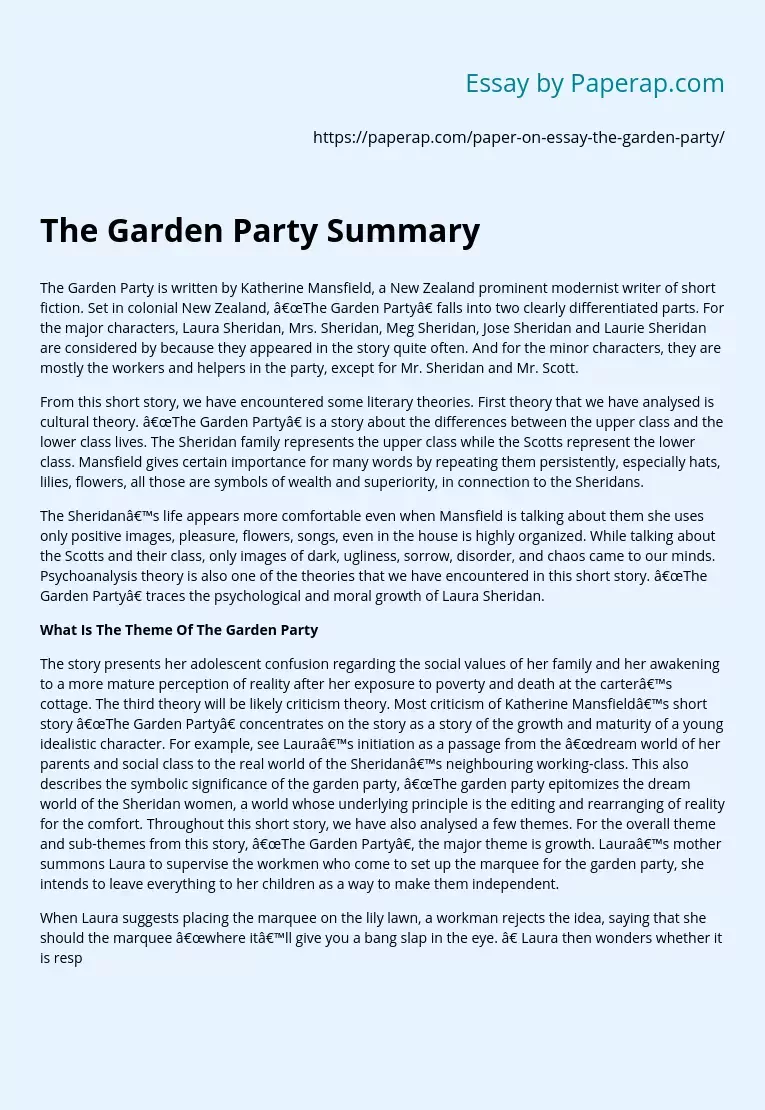The Garden Party Summary
The Garden Party is written by Katherine Mansfield, a New Zealand prominent modernist writer of short fiction. Set in colonial New Zealand, “The Garden Party” falls into two clearly differentiated parts. For the major characters, Laura Sheridan, Mrs. Sheridan, Meg Sheridan, Jose Sheridan and Laurie Sheridan are considered by because they appeared in the story quite often. And for the minor characters, they are mostly the workers and helpers in the party, except for Mr. Sheridan and Mr. Scott.
From this short story, we have encountered some literary theories.
First theory that we have analysed is cultural theory. “The Garden Party” is a story about the differences between the upper class and the lower class lives. The Sheridan family represents the upper class while the Scotts represent the lower class. Mansfield gives certain importance for many words by repeating them persistently, especially hats, lilies, flowers, all those are symbols of wealth and superiority, in connection to the Sheridans.
The Sheridan’s life appears more comfortable even when Mansfield is talking about them she uses only positive images, pleasure, flowers, songs, even in the house is highly organized.
While talking about the Scotts and their class, only images of dark, ugliness, sorrow, disorder, and chaos came to our minds. Psychoanalysis theory is also one of the theories that we have encountered in this short story. “The Garden Party” traces the psychological and moral growth of Laura Sheridan.
What Is The Theme Of The Garden Party
The story presents her adolescent confusion regarding the social values of her family and her awakening to a more mature perception of reality after her exposure to poverty and death at the carter’s cottage.
The third theory will be likely criticism theory. Most criticism of Katherine Mansfield’s short story “The Garden Party” concentrates on the story as a story of the growth and maturity of a young idealistic character. For example, see Laura’s initiation as a passage from the “dream world of her parents and social class to the real world of the Sheridan’s neighbouring working-class. This also describes the symbolic significance of the garden party, “The garden party epitomizes the dream world of the Sheridan women, a world whose underlying principle is the editing and rearranging of reality for the comfort. Throughout this short story, we have also analysed a few themes. For the overall theme and sub-themes from this story, “The Garden Party”, the major theme is growth. Laura’s mother summons Laura to supervise the workmen who come to set up the marquee for the garden party, she intends to leave everything to her children as a way to make them independent.
When Laura suggests placing the marquee on the lily lawn, a workman rejects the idea, saying that she should the marquee “where it’ll give you a bang slap in the eye. ” Laura then wonders whether it is respectful of a laborer to speak to a girl of her upbringing in the crude language of the common people. However, Laura ends up approving of the men even though they are the ones who choose the location for the marquee–against the karaka trees. Thus, though failing to supervise the men with authority, Laura learns to overlook class distinctions in dealing with the outside world.
The another theme will be the contrast between life and death. The Sheridan’s garden is a place of thoughtless pleasure and burgeoning energy, where young people resemble brilliant butterflies and arum lilies bloom with an almost frightening vitality. In contrast, the home of the dead carter is dark and oppressive, guarded by an aged crone and surrounded by a shadowy crowd. Mansfield deliberately exaggerates the difference between these two locations in order to emphasize her theme.
That life and death are part of the same continuum is suggested by the temporal structure of the story, which begins at dawn and ends in a gathering dusk. As many critics have noted, Laura’s journey to visit the bereaved family has strong mythic overtones and resembles the tale of Proserpina, a goddess who was abducted by Hades into the underworld. Laura’s moment of epiphany testifies to a kind of knowledge unavailable in the sunny world of the garden party. In this way, her journey also has the quality of an initiation rite, in which a naive young girl achieves emotional and moral maturity.
Last but not least, we realized that this short story is focused on third person point of view. It is because the narrator withholds information in favor of limiting what she says to what Laura thinks and experiences. Besides, she generally does not understand the incident of what she undergoes that day, at least not until the very end, when she says “isn’t life, isn’t life? ” only for her brother to interrupt her, misinterpret her, and silence the knowledge about death she had just obtained from visiting the cottage of the man who had died.
The Garden Party Summary. (2019, Dec 05). Retrieved from https://paperap.com/paper-on-essay-the-garden-party/

